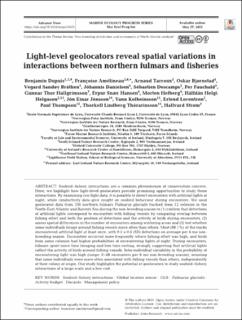Light-level geolocators reveal spatial variations in interactions between northern fulmars and fisheries
Dupuis, Benjamin; Amélineau, Françoise; Tarroux, Arnaud; Bjørnstad, Oskar; Bråthen, Vegard Sandøy; Danielsen, Jóhannis; Descamps, Sebastien; Fauchald, Per; Hallgrimsson, Gunnar Thor; Hansen, Erpur Snær; Helberg, Morten; Helgason, Halfdan Helgi; Jónsson, Jón Einar; Kolbeinsson, Yann; Lorentzen, Erlend; Thompson, Paul; Thórarinsson, Thorkell Lindberg; Strøm, Hallvard
Peer reviewed, Journal article
Published version

Åpne
Permanent lenke
https://hdl.handle.net/11250/2758712Utgivelsesdato
2021Metadata
Vis full innførselSamlinger
- Publikasjoner fra CRIStin - NINA [2364]
- Scientific publications [1392]
Originalversjon
10.3354/meps13673Sammendrag
Seabird−fishery interactions are a common phenomenon of conservation concern.
Here, we highlight how light-level geolocators provide promising opportunities
to study these interactions. By examining raw light data, it is possible to detect
encounters with artificial lights atnight, while conductivity data give insight on
seabird behaviour during encounters. We used geolocator data from 336 northern
fulmars Fulmarus glacialis tracked from 12 colonies in the North-East Atlantic and
Barents Sea during the non-breeding season to
(1) confirm that detections
of artificial lights correspond to encounters with fishing vessels by comparing
overlap between fishing effort and both the position of detections and the activity
of birds during encounters,
(2) assess spatial differences in the number of encounters among wintering areas and
(3) test whethersome individuals forage around fishing vessels more often than others.
Most (88.1%) of the track encountered artificial light at least once, with
9.5 ± 0.4 (SE) detections on average per 6 mo nonbreeding season. Encounters occurred
more frequently where fishing effort was high, and birds from some colonies had higher
probabilities of encountering lights at night. During encounters, fulmars spent more
time foraging and less time resting, strongly suggesting that artificial lights
reflect the activity of birds around fishing vessels. Inter-individual variability
in the probability of encountering light was high (range: 0−68 encounters per 6 mo
non-breeding season), meaning that some individuals were more often associated with
fishing vessels than others, independently of their colony of origin. Our study
highlights the potential of geolocators to study seabird−fisheryinteractions at
a large scale and a low cost.
